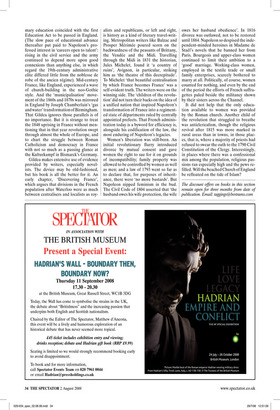A country of ruins
Robert Stewart
CHILDREN OF THE REVOLUTION: THE FRENCH, 1799-1914 by Robert Gildea Allen Lane, £30, pp. 540, ISBN 9780713997606 ✆ £24 (plus £2.45 p&p) 0870 429 6655 Contributers to multi-volume national histories are usually straitjacketed, expected to keep to well-trodden paths. But Robert Gildea’s subtitle is ‘the French’, not France, and in the third volume of the New Penguin History of France to be published he wanders freely. Foreign policy, for example, gets short shrift. Instead, a chapter is devoted to the French view of foreigners. Mathematics, science and medicine are sidelined, but the treatment of women is spacious. The political chapters are there and so are the socioeconomic ones. The political narrative down to 1870, awash with names, is a bit helter-skelter. Of little interest to the initiated, it may have green undergraduates reeling. The handling of economic and social matters is livelier, partly because Gildea makes no attempt to be exhaustive: no discussion, beloved of English historians of the period, of rising or falling standards of living, no mention of birth and death rates. The poverty of statistics has always made conclusions about such things tentative, to say the least, and Gildea relies instead, as he does elsewhere in the book, on brief lives, thumbnail sketches offered as exemplary. Some readers may think there are too many of them, but that is a matter of taste.
Echoes of British history abound. Secret trade unions were banned in France in 1834, the very year that the Tolpuddle martyrs were transported to Australia for swearing secret oaths. An 1833 law requiring every commune to provide pri mary education coincided with the first Education Act to be passed in England. (The slow pace of educational advance thereafter put paid to Napoleon’s professed interest in ‘careers open to talent’: rising in the civil service and the army continued to depend more upon good connexions than anything else, in which regard the 19th-century administrative elite differed little from the noblesse de robe of the ancien régime). Mid-century France, like England, experienced a wave of church-building in the neo-Gothic style. And the ‘municipalisation’ movement of the 1860s and 1870s was mirrored in England by Joseph Chamberlain’s ‘gas and water’ transformation of Birmingham. That Gildea ignores those parallels is of no importance. But it is strange to treat the 1848 uprising in France without mentioning that in that year revolution swept through almost the whole of Europe, and to chart the struggle between Roman Catholicism and democracy in France with not so much as a passing glance at the Kulturkampf in Bismarck’s Germany.
Gildea makes extensive use of evidence provided by writers, especially novelists. The device may be old-fashioned, but his book is all the better for it. An early chapter, ‘Discovering France’, which argues that divisions in the French population after Waterloo were as much between centralisers and localists as roy alists and republicans, or left and right, is history as a kind of literary travel-writing. Metropolitan writers like Balzac and Prosper Mérimée poured scorn on the backwardness of the peasants of Brittany, the Vendée and the Midi. Travelling through the Midi in 1831 the historian, Jules Michelet, found it ‘a country of ruins’, Avignon, in particular, striking him as ‘the theatre of this decrepitude’. To Michelet ‘that beautiful centralisation by which France becomes France’ was a self-evident truth. The writers were on the winning side. The ‘children of the revolution’ did not turn their backs on the idea of a unified nation that inspired Napoleon’s transformation of France into a regimented state of départments ruled by centrally appointed prefects. That French administration today is a byword for efficiency is, alongside his codification of the law, the most enduring of Napoleon’s legacies.
Women’s liberation was still-born. An initial revolutionary flurry introduced divorce by mutual consent and gave women the right to sue for it on grounds of incompatibility; family property was allowed to be controlled by women as well as men; and a law of 1793 went so far as to declare that, for purposes of inheritance, there were ‘no more bastards’. But Napoleon nipped feminism in the bud. The Civil Code of 1804 asserted that ‘the husband owes his wife protection, the wife owes her husband obedience’. In 1816 divorce was outlawed, not to be restored until 1884. Napoleon so despised the independent-minded heroines in Madame de Staël’s novels that he banned her from Paris. Bourgeois and upper-class women continued to limit their ambition to a ‘good’ marriage. Working-class women, employed in the textile trade or small family enterprises, scarcely bothered to marry at all. Politically, of course, women counted for nothing, and even by the end of the period the efforts of French suffragettes paled beside the militancy shown by their sisters across the Channel.
It did not help that the only education available to women was provided by the Roman church. Another child of the revolution that struggled to breathe was anticlericalism, though the religious revival after 1815 was more marked in rural areas than in towns, in those places, that is, where a majority of priests had refused to swear the oath to the 1790 Civil Constitution of the Clergy. Interestingly, in places where there was a confessional mix among the population, religious passions ran especially high and the pews refilled. Will the beached Church of England be refloated on the tide of Islam?
The discount offers on books in this section remain open for three months from date of publication. Email: taggings@bertrams.com



























































 Previous page
Previous page